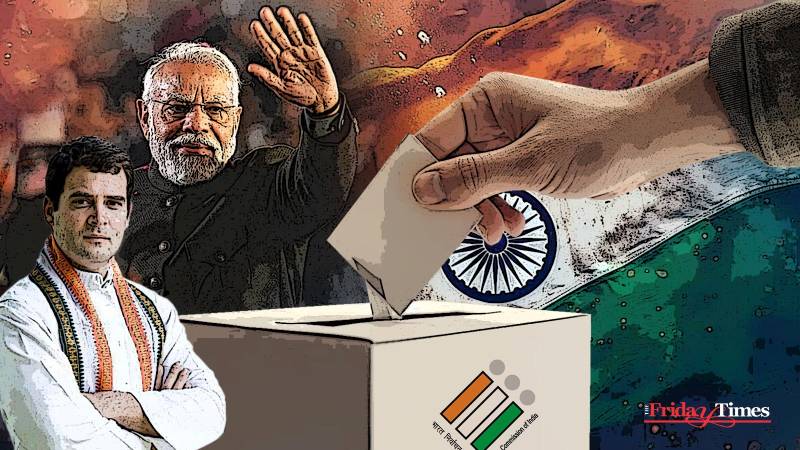
As the marathon 7-phase polling for India’s general elections concluded on June 1, pollsters announced a historic hat-trick for incumbent Prime Minister Narendra Modi, with a slightly bigger majority but somewhat short of his targeted 400 mark. Every exit poll conducted by notable agencies and news channels has projected 350 plus parliamentary seats for the BJP-headed National Democratic Alliance (NDA).
The Congress-led INDIA bloc is making marginal improvement with an estimated tally of 140-160 seats.
There are a total of 543 Lok Sabha seats, and 272 are needed to secure a majority. The final count and tally of votes will take place on Tuesday, June 4.
| Source | BJP-led NDA | Congress and INDIA | Others |
| India News-D-Dynamics | 371 | 125 | 47 |
| Jan Ki Baat | 362-392 | 141-161 | 10-20 |
| News Nation | 342-378 | 153-169 | 21-23 |
| Republic Bharat-Matrize | 353-368 | 118-133 | 43-48 |
| Republic TV-P MARQ | 359 | 154 | 30 |
Explaining the exit polls
The exit polls announced half an hour after the last vote cast were found predicting a similar final outcome. They have however also gone wrong on several occasions and some news channels had to even apologize for misleading the public. There has been feeble clarity on how the agencies or media organizations conduct their surveys or what their sample size is.
They nevertheless stir nationwide curiosity and their propensity towards coming true makes them much sought-after.
Often these surveys get circulation in some media circles in advance and thus media persons always have advance wind of their projections. Even political parties seem to be aware of them well in advance. The Congress leadership announced a day in advance not to partake in TV discussions following the telecast of exit polls, hinting that it knew its alliance was trailing.
How BJP-led NDA is gaining
In many poll analyses, BJP and its alliance partners were expected to put up subdued performances in states in the South, Maharashtra, Bihar and others. It had bolstered the opposition and people foresaw a sharp dip in numbers of the BJP bloc. The perception had gathered momentum after the first phase of polling. When PM Modi resorted to Muslim-bashing and a political language that, according to former PM Manmohan Singh, lowered the dignity of the PM post, the perception that the BJP was facing acute anti-incumbency seems to have been verified. But, the exit poll trends have proved otherwise.
If we believe that exit polls are reporting the truth, then the NDA is maintaining its dominance in Karnataka and Maharashtra. The Left-led alliance is facing a rout in Kerala. The Congress-led United Democratic Front (UDF) is set to sweep Kerala once again in 2024, while the BJP-led NDA will make inroads in the southern state.
After PM Modi’s big Southern push, NDA may get up to five seats in Tamil Nadu, predict exit polls. Tamil Nadu has 39 Lok Sabha seats.
In Bengal, the exit polls have predicted a better performance for the BJP than it did the last time (22). At least three exit polls have said that the BJP will now be the single-largest party in Bengal in terms of Lok Sabha seats.
The BJP may win 15 of Odisha’s 21 seats, Naveen Patnaik's BJD likely to get 3-8, indicated exit polls.
In Telangana too, the Congress may be unable to capitalize on the assembly poll victory and the decimation of former popular chief minister K Chandrasekhar Rao’s Bharat Rashtra Samithi, exit polls indicate. The BJP is likely to walk away with over half of the state’s 17 seats.
The party will also continue to dominate bastions like Gujarat, Madhya Pradesh, Uttar Pradesh, Uttarakhand, Himachal Pradesh, and national capital Delhi.
Change, though, is expected in Bihar, which had given 39 of its 40 seats to the NDA in the last election. The Opposition alliance, spearheaded by Tejashwi Yadav’s Rashtriya Janata Dal, is expected to walk away with 7 seats.
The forecast at Sangam
Beyond the prosaic mosaic of predictions, a journalist travels to Prayagraj, earlier Allahabad, to read the result of Indian elections swimming across the waters of the Ganga. The greatest and most revered Indian river merges with its divine sister Yamuna at Sangam where, the myth goes, another divine rivulet Saraswati emerges. The belief attracts pilgrims from across India and thus Jawaid Laiq, former assistant editor with the left-leaning Economic and Political Weekly magazine, takes a boat ride to read the minds of these pilgrims and the local boatmen.
Based on these percipient inputs, Laiq has been getting it right since 1977 when the Janata Party trounced Gandhi’s Congress, even though it was an easy guess then. However, few could believe when he prophesied the fall of Atal Bihari Vajpayee’s mighty government in 2004, or later when he prognosticated another term for Manmohan Singh in 2009. In 2014, like in 1977, it was easy to see Modi becoming PM on the back of BJP’s astounding victory. However, few would see BJP returning to power with an even bigger majority in 2019, but Laiq was confident of it.
“Astonishingly, the election forecasts made by the boatmen and pilgrims over decades have proved to be relatively more accurate than the election predictions of the professional pollsters and political pundits,” he wrote of his experience for the portal The Wire.
Two weeks ago, Laiq went to Sangam with his journalist wife Bharti Srivastava. It was when the dice were believably turning against BJP and people said that “chunaav palat gaya hai (election has turned upside down)”. Laiq and his better half interviewed Indians of almost all castes and regions, and drew the denouement that the wind has blown once again in favor of the BJP, and that Modi will score a hat-trick.

